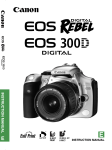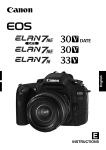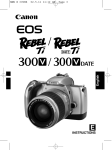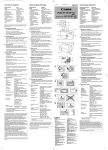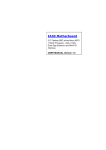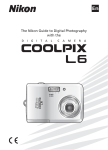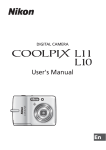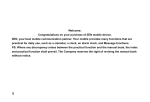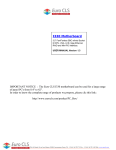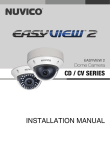Download Canon 300X Instruction manual
Transcript
/ English / E INSTRUCTION MANUAL Thank you for purchasing a Canon product. The EOS REBEL T2 (DATE) / 300X (DATE) is a very compact autofocus, single-lens reflex camera. It can be used for a wide variety of subjects and situations with fully automatic and usercontrolled shooting modes. Read this Instruction manual and familiarize yourself with your new camera before taking pictures. Also read “Handling Cautions” on page 4 to prevent camera malfunction and damage. Before Using Your Camera • Before shooting an important event, be sure to take test shots to make sure the camera operates properly. • EOS cameras have a lens mount for dedicated operation (autofocusing, exposure control, etc.) with Canon EF lenses. Using a non-Canon EF lens with an EOS camera may not result in proper camera or lens operation. Note that the warranty does not cover any camera malfunction or damage occurring with the use of non-Canon products. Conventions Used in this Instruction manual • The <l> icon indicates the Main Dial. • All operation procedures described in this booklet assume that the Mode Dial is set to a mode except <:>. Before proceeding with any operation, be sure that the Mode Dial is set to a shooting mode. • Reference page numbers are indicated by (p.∗∗). • The ★ symbol indicates that the respective feature can be used only in Creative Zone modes (T, R, E, W, Q). • The camera control icons and markings used in this booklet correspond to the actual icons and markings found on the camera. • The (˜) and (∫) icons indicate that the respective function remains in effect for 4 and 6 sec. respectively after the button is released. 2 Contents Conventions Used in this Instruction manual .....................2 Handling Cautions ..............................................................4 Nomenclature .....................................................................6 1 Before You Start 11 Installing the Batteries ......................................................11 Checking the Battery Level ..............................................12 Mounting and Detaching a Lens.......................................13 How the Shutter Button Works .........................................14 =Loading and Unloading Film ........................................15 ¢Midroll Rewind ......................................................16 2 Fully Automatic Shooting 17 Since everything is automatic, all you do is press the shutter button. 3 User-Controlled Shooting 27 You can set the desired shutter speed or aperture value to obtain the exposure you want. You take control of the camera. Reference 49 Symbols The Caution symbol alerts you to actions to prevent shooting problems. The Note symbol gives supplemental information. 3 Handling Cautions Camera Care and Storage • The camera is a precision instrument. Do not drop it or subject it to physical shock. • The camera is not waterproof and should not be used in wet conditions or underwater. If the camera gets wet, take it to your nearest Canon dealer as soon as possible. If small amounts of water splash onto the camera, wipe it with a clean dry cloth. If the camera is exposed to salty air, wipe it thoroughly with a slightly damp cloth. • Do not leave the camera in places prone to excessive heat such as in a car on a sunny day. Excessive heat can cause the camera to malfunction. • The camera contains precision electronic circuitry. Never attempt to disassemble the camera. • Use only a blower brush to blow away any dust on the lens, eyepiece, mirror, focusing screen, film compartment, etc. Do not clean the camera body or lens with any cleaner containing an organic solvent. For stubborn dirt, consult your nearest Canon Service Center. • The shutter curtains are extremely thin. Use only a blower to clean them. Be careful not to blow air too forcefully on the shutter curtains. The shutter curtains can be easily deformed or damaged. Also, when loading and unloading film, be careful not to touch the shutter curtains. • Do not touch the electrical contacts with your fingers. Otherwise corrosion may develop on the contacts, resulting in improper camera operation. • If the camera is not to be used for an extended period, remove the battery. Store the camera in a well-ventilated, cool, dry place. During the storage period, press the shutter button to release the shutter a few times once in a while. • Avoid storing the camera in a laboratory, cabinet, etc., where corrosive chemicals are present. 4 • If the camera has not been used for a prolonged period or if you will use the camera for an important event, check the operation of all the camera controls or take the camera to your nearest Canon Service Center. LCD Displays By their nature, LCD displays react more slowly at low temperatures, and may appear dark at high temperatures. The display will return to normal at room temperature. Batteries • Before installing the batteries, wipe the battery contacts to remove any fingerprints and smudges. This is to prevent faulty connections and corrosion. • Never disassemble or recharge the batteries. Also, never store a battery in high-temperature places or short circuit the battery contacts or toss a battery into a fire. • Although the batteries work well even at low temperatures, battery performance may decline slightly at freezing temperatures. In such a case, keep spare batteries warm in a pocket, etc., and use and warm the batteries alternately. How Low Battery Levels Affect Camera Operation On the LCD panel, if the <π> icon blinks or it is not displayed, a proper exposure can still be obtained as long as the shutter releases. However, when the battery level is low, film advance and auto rewind might stop midway or not work at all and <π> icon may blink on the LCD panel. After the batteries are replaced with new ones, film advance will be possible and film rewind can resume by pressing the <¢> button. Lens Electrical Contacts After detaching the lens from the camera, put on the lens caps or put down the lens with the rear end up to avoid scratching the lens surface and electrical contacts. Contacts 5 Nomenclature • Reference page numbers are indicated by (p.∗∗). Built-in flash / AF-assist beam (p.44/19) <^> Film advance mode / Self-timer/*Remote control button (p.32/23/24) Mode Dial (p.10) Red-eye reduction lamp (p.22) Hot shoe Flash-sync contact <M> Flash button (p.44) <£> Film plane mark <l> Main Dial Shutter button (p.14) Strap mount (p.7) *Remote control sensor / Self-timer/ *Remote control lamp (p.24/23/24) Remote control terminal** Grip / Battery compartment (p.11) Lens release button (p.13) Depth-of-field preview button(p.42) Focus mode switch (p.13) Zooming ring Focusing ring (p.31) Body cap (p.13) 6 * DATE Model only **For Remote Switch RS-60E3 (sold separately). Viewfinder eyepiece Eyecup (p.26) Film check window <4> AF mode/*SET button (p.28/26) < > Aperture set/Exposure compensation button (p.37/39) <j> AE lock/FE lock button (p.41/46) Back cover release lever (p.15) <3> AF point selection button (p.29) AF point selection keys (p.29) <\> Function button (p.22, 25, 26, 40, 42, 43, 44, 47) LCD panel (p.8) <¢> Midroll rewind button (p.16) Tripod socket <6> LCD panel illumination button Back cover Guide hole Battery compartment cover release lever (p.11) Battery compartment cover (p.11) Attaching the Strap 2 1 3 4 Pass the end of the strap through the camera’s strap mount from the bottom. Then pass it through the strap’s buckle as shown in the illustration. Pull the strap to make sure it does not slip out of the buckle. • The eyepiece cover is also attached to the strap. (p.24) Eyepiece cover 7 Nomenclature LCD Panel Shutter speed ISO film speed Date FE lock DATE Model Shooting mode icon AF Mode One-Shot AF AI Focus AF AI Servo AF Battery level mark <=> Film mark Film advance mode <J> Single frame <H> Continuous shooting <´> Self-timer/ Remote control Non-DATE Model <?> Manual focus Aperture value Red-eye reduction setting AEB amount Date Date ISO film speed Red-eye reduction Beeper Safety release lock Multiple exposures AEB Custom Function <>> Function pointer Frame counter Multiple-exposure setting Self-timer operation Remote control operation Custom Function icon Exposure level indicator Exposure compensation amount AEB level Red-eye reduction lamp-on indicator Film transport indicator • Pressing the <6> button illuminates the LCD panel. • The actual display will show only the applicable items. 8 Viewfinder Information AF points (7) Superimposed display <j> AE lock / FE lock AEB in progress <M> Flash-ready Improper FE lock warning <|> *High-speed sync (FP flash) Shutter speed FE lock Focusing screen <n> Focus confirmation light Exposure level indicator Exposure compensation amount AEB level Red-eye reduction lamp-on indicator Aperture value Remove the eyecup, then slide the dioptric adjustment lever left or right until the AF points in the viewfinder look sharp. * With an EX-series Speedlite. 9 Nomenclature Mode Dial The dial is divided into two zones. ea Cr tive Zone OFF Full Auto Im a g e Zon e B a sic Zone 1 Basic Zone Fully automatic mode where the camera takes care of everything. Y : Full Auto (p.18) Basically, all you do is point and shoot. Image Zone (p.20) Fully automatic modes for a particular subject. U : Portrait I : Landscape O : Close-up P : Sports A : Night Portrait S : Flash off 10 2 Creative Zone Semi-automatic and manual modes enable you to take control of the camera to obtain the desired result. T : Program AE (p.33) R : Shutter-priority AE (p.35) E : Aperture-priority AE (p.36) W : Manual exposure (p.37) Q : Automatic Depth-offield AE (p.38) 3 : : OFF 1 Before You Start Installing the Batteries ∗ Batteries are not included in camera body only (not kit) sold in North America. Obtain batteries separately. The camera uses two CR2 lithium batteries. 2 the battery compartment 1 Open cover. • Slide the release lever in the 1 direction shown by the arrow in the diagram, and open the cover. the batteries. 2 Install • Make sure the battery contacts (+ and –) are properly oriented as shown. • Do not mix old and new batteries. the battery compartment 3 Close cover. • Press the cover until it snaps shut. • The date and time must be set. See page 26. (DATE Model only) For places where CR2 batteries may not be easily available, take spare batteries with you. Also carry spare batteries for extended shooting sessions. 11 Checking the Battery Level Check the battery level after replacing the batteries and before using the camera. Turn the Mode Dial to a shooting mode. • The camera will then turn on and the LCD panel will display one of the following battery level mark: : Battery level OK. : The battery level is low. Keep spare batteries handy. : The batteries will soon be completely exhausted. : Replace the batteries. Battery Life (With 24-ex. rolls) Temperature 0% Flash Use 50% Flash Use 100% Flash Use At 20˚C 54 rolls 23 rolls 16 rolls At –10˚C 35 rolls 16 rolls 11 rolls • The battery life shown above is based on Canon’s testing conditions with new batteries. • If nothing is displayed on the LCD panel, the batteries may have been installed incorrectly. Take out the batteries and install correctly. • If you often press the shutter button halfway for a prolonged period or just autofocus without taking a picture, the battery life will be affected. • When not using the camera, set the Mode Dial to <:>. 12 Mounting and Detaching a Lens Mounting a Lens the caps. 1 Remove • Remove the rear lens cap and the camera body cap. the lens. 2 Mount • Align the red dots on the lens and camera and turn the lens as shown by the arrow until it snaps in place. Red dots the lens, set the focus mode 3 On switch to <AF>. • If the focus mode switch is set to <MF>, autofocus will not operate. 1 2 1 4 Remove the front lens cap. Detaching the Lens While pressing the lens release button, turn the lens as shown by the arrow. 2 1 • Turn the lens until it stops, then detach it. 3 • Keep the removed caps where you will not lose them. • <AF> stands for “Auto Focus,” and <MF> stands for “Manual Focus.” • An EF-S lens cannot be attached to the camera. 13 How the Shutter Button Works The shutter button has two stages. You can press it down halfway or fully. The two levels of shutter button operation are as follows: When it is pressed halfway: • Pressing the shutter button down halfway activates autofocusing (AF), and also activates the automatic exposure (AE) mechanism and sets the shutter speed and aperture value. • The exposure (the combination of shutter speed and aperture value) appears on the LCD panel and in the viewfinder (˜). When it is pressed fully: • The shutter is released to take the picture and the film advances by one frame. If an Extender (optional) is used and the maximum aperture (the lowest f/number) of the lens becomes smaller than f/5.6, autofocusing will not operate. For details, refer to the extender's instructions. Camera movement during the moment of exposure is called camera shake. Camera shake can cause blurred pictures. To prevent blurred pictures due to camera shake: • Hold the camera steady. · Firmly grasp the camera grip with your right hand, and press your both elbows lightly against your body. · Hold the lens at the bottom with your left hand. · Press the camera against your face and look through the viewfinder. · To maintain a stable stance, place one foot in front of the other instead of lining up both feet. • Use your finger tip to touch the shutter button, grasp the camera with your entire right hand, then press the shutter button gently. 14 =Loading and Unloading Film Loading Film After you load the film, the camera first winds the entire roll onto the camera’s take-up spool. With DX-coded film, the camera automatically sets the film’s ISO speed. Then each time a picture is taken, one frame of film is rewound back into the film cartridge. The frame counter shows always number of shots remaining. the Mode Dial to any 1 Turn setting except <:>. the back cover. 2 Open • the film cartridge at a 3 Insert slight angle. the film leader edge with 4 Align the <§> mark. Slide down the back cover release lever and open the back. • Hold down the film cartridge while Wrong pulling out the film leader. If you pull out the film leader too much, rewind it back into the film cartridge. the back cover. 5 Close • Close the back cover until it snaps shut. s Film prewind will start and there will be a shutter-release sound about 10 sec. later. The <=> icon and frame count will also be displayed on the LCD panel. s During the film prewind, the ISO speed will be displayed on the LCD panel. 15 =Loading and Unloading Film • The shutter curtains have been manufactured with very high precision. Never touch them with your fingers. When loading film, do not touch or damage the curtains with your fingers or film. • In hot and humid environments, do not remove the film packaging until you are ready to load the film. • Infrared film cannot be used with this camera. If the film is not loaded properly, the <=> icon will blink on the LCD panel and the shutter will not work. Reload the film cartridge properly. Unloading Film After the film’s last frame is exposed, the camera rewinds the film automatically. After the film is rewound, there will be a shutter-release sound. Check that the <=> icon is blinking on the LCD panel, then open the back cover and take out the film cartridge. ¢Midroll Rewind To rewind the film in midroll, follow the procedure below. Press the <¢> button. s Film rewind will begin. • Make sure the <=> icon is blinking, then take out film cartridge. If you take out the film cartridge in midroll without rewinding the film and then load a new roll of film and press the shutter button completely, the new film will only rewind into the cartridge. Before loading a new roll of film in this case, close the camera back and press the shutter button. 16 Fully Automatic Shooting YFull Auto Mode ......................................................18 AF-Assist beam with the Built-in Flash .................19 2 Programmed Image Control Modes ...........................20 UPortrait / ILandscape / OClose-up / PSports / ANight Portrait / SFlash off FUsing Red-eye Reduction .....................................22 q Self-timer Operation ..............................................23 K Wireless Remote Control (DATE Model only) ...........24 Using the Eyepiece Cover..........................................24 ;Imprinting the Date or Time (DATE Model only) .....25 This section explains how to use the camera's Basic Zone modes <Y> <U> <I> <O> <P> <A> <S> on the Mode Dial for quick and easy shooting. Each Basic Zone mode suits a particular subject. The film advance mode, flash, and other functions are set automatically. You just press the shutter button. Turn the Mode Dial to <Y>, <U>, <I>, <O>, <P>, <A> or <S>. • The picture-taking procedure is the same as with the “<Y> Full Auto mode” on page 18. B as ic Zone 17 YFull Auto Mode All you do is point the camera and press the shutter button. Everything is automatic so it is easy to photograph any subject. With seven AF points to focus the subject, anyone can just point and shoot. 1 Turn the Mode Dial to <Y>. any of the AF points on the 2 Aim subject. • Out of the seven AF points, the one covering the closest subject is selected automatically to achieve focus. AF point the subject. 3 Focus • Press the shutter button halfway to focus. s When focus is achieved, the AF point mark and focus confirmation light <n> in the viewfinder will flash. s When necessary, the built-in flash will pop up automatically. Shutter speed Aperture value the exposure setting. 4 Check The shutter speed and aperture s Focus confirmation light 18 value will be set automatically and displayed in the viewfinder and on the LCD panel. the picture. 5 Take • Compose the shot and press the shutter button fully. • If you want to zoom, do it before focusing. Turning the zooming ring after achieving focus may throw off the focus. • If the built-in flash’s pop-up operation is obstructed, the <π> icon will blink on the LCD panel. Press the shutter button halfway to resolve the problem. • When focus is achieved, the autofocus and auto exposure setting will also be locked. • If the focus confirmation light <n> blinks, the picture cannot be taken. (p.30) • If multiple AF point marks will light, it means that all of them have achieved focus at the respective points. • In the Basic Zone modes (except <I> <P> <S> ), the built-in flash will pop up and fire automatically in low-light or backlit conditions. To retract the flash, push it back down. • If you want to use a certain AF point to focus, set the Mode Dial to <T> and select the AF point manually. (p.29) AF-Assist beam with the Built-in Flash Under low-light conditions, the built-in flash fires a brief burst of flashes when you press the shutter button halfway. This is to illuminate the subject to enable easier autofocusing. • The AF-assist beam does not function in the <I> <P> <S> modes. • The AF-assist beam is effective up to about 4 meters/13.1 feet. • In the Creative Zone modes when the built-in flash is popped up with the <M> button, the AF-assist beam may be emitted. 19 Programmed Image Control Modes Select a shooting mode to suit the target subject, and the camera will be set to obtain the best results. U Portrait This mode blurs the background to make the human subject stand out. • Holding down the shutter button executes continuous shooting. • To improve the background blur, use a telephoto lens and fill the frame with the subject or have the subject stand farther away from the background. I Landscape This is for wide scenic views, night scenes, etc. • Using a wide-angle lens will further enhance the depth and breadth of the picture. O Close-up Use this mode to take close-up shots of flowers, insects, etc. • As much as possible, focus the subject at the lens’ closest focusing distance. • To obtain a larger magnification, use the telephoto end of a zoom lens. A blinking shutter speed indicates that the shutter speed is too slow to prevent a blurred picture due to camera shake. Be careful to hold the camera steady and press the shutter button smoothly, or use a tripod. (The shutter speed indicator still blinks when you use a tripod, but camera shake will not be a problem.) 20 P Sports This is for fast-moving subjects when you want to freeze the action. • The camera will first track the subject with the center AF point. Focus tracking will then continue with any of the seven AF points covering the subject. When focus is achieved, the beeper will sound softly. • While you hold down the shutter button, focusing will continue for continuous shooting. • Using a telephoto lens and ISO 400 or higher speed film is recommended. A Night Portrait This mode is for taking pictures of people at twilight or at night. The flash illuminates the subject while a slow sync speed obtains a natural-looking exposure of the background. • If you want to photograph only a night scene (without people), use the <I> mode instead. • Tell the subject to keep still even after the flash fires. Use a tripod to prevent camera shake. S Flash off You can disable the flash when you do not want it to fire. • The built-in flash or any external Speedlite will not fire. 21 FUsing Red-eye Reduction (with the built-in flash) When flash is used in a low-light environment, the subject’s eyes may come out red in the photograph. To reduce this “Red eye” the red-eye reduction lamp shines a light into the subject’s eyes before the flash is fired. Red-eye reduction works in all shooting modes except <I> <P> <S>. Move the <>> arrow to the 1 <F> icon on the LCD panel. • Look at the LCD panel and press the <\> button to move the arrow. (∫) Turn the <l> dial to set “ 2 on the LCD panel. ” • Press the shutter button halfway to return to normal camera operation. • To cancel red-eye reduction, set “ ” on the LCD panel. • When you press the shutter button halfway, the red-eye reduction lamp-on indicator will appear in viewfinder and on the LCD panel. Red-eye reduction • Red-eye reduction will not work unless lamp-on indicator the subject looks at the red-eye reduction lamp. Tell the subject to look at the lamp. • For maximum effectiveness, press the shutter button fully after the red-eye reduction lamp turns off (after 1.5 sec.). • You can take a picture even while the red-eye reduction lamp is lit. • The effectiveness of red-eye reduction varies depending on the subject. • To further increase the effectiveness of red-eye reduction, go to a brighter environment or move closer to the subject. 22 qSelf-timer Operation You can use self-timer in any Basic mode or Creative mode. We recommend using a tripod when you use the self-timer. the <^> button. 1 Press • While looking at the LCD panel, press the <^> button to select <´>. the picture. 2 Take • The picture-taking procedure is the same as with the <Y> Full Auto mode on page 18. • Look through the viewfinder and press the shutter button fully to start the self-timer. s The picture will be taken about 10 sec. later. First 8 sec.: Self-timer lamp blinks slowly. Final 2 sec.: Self-timer lamp blinks quickly. s During the self-timer operation, the LCD panel counts down the seconds until the picture is taken. Do not stand in front of the camera when you press the shutter button to start the self-timer. Doing so prevents the camera from focusing on the subject. • To cancel the self-timer after it starts, press the <^> button. • When using the self-timer to take a picture of only yourself, first lock the focus (p.30) on an object at the same distance where you will be in the picture. 23 KWireless Remote Control (DATE Model only) With Remote Controller RC-5 (optional), wireless operation is possible up to 5 m/16.4 ft away from the front of the camera. the <^> button. 1 Press • While looking at the LCD panel, press the <^> button to select <´>. the picture. 2 Take • Point the controller toward the Remote control sensor camera’s remote control sensor and press the transmit button. s Taken about 2 sec. later. • The indicator will be the same as during the last 2 sec. of the self-timer. Certain types of fluorescent lights might cause the remote control operation to work improperly. Place the camera away from any fluorescent lights as far as possible. If you set <´> and do nothing for four minutes, the remote control mode will be canceled automatically to save battery power. Using the Eyepiece Cover During self-timer or remote control operation when your eye does not cover the viewfinder eyepiece, stray light may enter the eyepiece and affect the exposure when the picture is taken. To prevent this, use the eyepiece cover to cover the eyepiece. (p.7) the eyecup from the 1 Remove eyepiece. the eyepiece cover. 2 Attach • Slide the eyepiece cover down into the eyepiece groove to attach it. 24 ;Imprinting the Date or Time (DATE Model only) The camera has a date feature with an automatic calendar to 2099. It can imprint the date or time on the photograph as shown in the left photo. The date or time can be imprinted in any shooting mode. Date position the <>> arrow to <;>. 1 Move • Look at the LCD panel and press the <\> button. (∫) • If the date and time has not been set, “ ” will blink on the LCD panel. See page 26 to set the date and time. the date format. 2 Select • Turn the <l> dial. s The date format will change in the following loop: Year, month, day Month, day, year Blank Day, month, year Day, hour, minute 25 ;Imprinting the Date or Time (DATE Model only) Setting the Date and Time 1 Move the <>> arrow to <;>. the digit to be set. 2 Select • Press the <[> button. • The digit selection will change in the following sequence: year, month, day, hour, minute, “ ”. the correct number. 3 Set • Turn the <l> dial. • Repeat steps 2 and 3 until all the date and time digits are set correctly. the date and time setting. 4 Finalize • Keep pressing the <[> button until no digits are blinking. • If you press the <[> button while “ ” is blinking, 0 sec. will be set. If a picture is taken while the date and time are blinking, the date and time will not be imprinted on that picture. The date and time setting can be retained for about 10 min. after the camera’s batteries are removed. 26 User-Controlled Shooting Crea tiv Selecting the AF mode ................................................28 3Selecting the AF point ............................................29 Focus Lock ............................................................30 When Autofocus Fails (Manual Focusing) ..................31 HSelecting the Film Advance Mode .........................32 Metering Modes...........................................................32 T Program AE ............................................................33 R Shutter-Priority AE ................................................35 E Aperture-Priority AE .............................................36 W Manual Exposure ...................................................37 Q Automatic Depth-of-Field AE..............................38 ∑Exposure Compensation.....................................39 LAuto Exposure Bracketing (AEB) ..........................40 jAE Lock ..................................................................41 <Multiple Exposures ................................................42 Depth-of-Field preview ................................................42 D Setting the ISO Film Speed.................................43 8Beeper Setting........................................................43 7Safety Release Lock ..............................................44 Using the Built-in Flash ...............................................44 5Setting Custom Functions ...................................47 e ne Zo 3 With Creative Zone modes, you can set the desired shutter speed or aperture value to obtain the exposure you want. You take control of the camera. • A ★ next to the page title indicates that the feature is available only in Creative Zone modes. 27 Selecting the AF mode★ The AF mode is the AF operation method. Three AF modes are provided: ONE SHOT (One-Shot AF), AI FOCUS (AI Focus AF), and AI SERVO (AI Servo AF). Select the AF mode. • Press the <4> button (∫) and turn the <l> dial. ONE SHOT (One-Shot AF) For still subjects. When you press the shutter button halfway, the AF focuses once. s When focus is achieved, the AF point achieving focus flashes in red and the focus confirmation light <n> in the viewfinder lights. The exposure is also set. AI FOCUS (AI Focus AF) This mode switches the AF mode automatically to One-Shot AF or AI Servo AF depending on whether the subject is still or moving. • Ideal for moving subjects whose distance from the camera keeps changing. • The exposure is set at the moment the picture is taken. AI SERVO (AI Servo AF) For moving subjects. While you hold down the shutter button, the camera continues to focus the subject approaching or moving away from the camera. • Ideal for moving subjects whose distance from the camera keeps changing. • The exposure is set at the moment the picture is taken. • The beeper will not sound when focus is achieved. 28 3Selecting the AF point★ The AF point is used for focusing. The AF point can be selected automatically by the camera or manually by you. In the Basic Zone modes and <Q> mode, the AF point selection is automatic only. In the <T> <R> <E> <W> modes, the AF point can be selected either automatically or manually. • Automatic AF point Selection The camera selects the AF point automatically according to situation. • Manual AF point Selection You can select any of the seven AF points manually. This is best when you want to be sure to focus on a particular subject, or to compose a particular shot quickly. the <3> button. 1 Press The currently-selected AF point will (∫) s light. the desired AF point. 2 Select • While looking at the AF point on the Select with cross keys Automatic selection Automatic selection Automatic selection Automatic selection LCD panel or in the viewfinder, press the cross keys to select the desired AF point. • To select a horizontal AF point, press the left or right cross key. To select a vertical AF point, press the top or bottom cross key. • You can also turn the <l> dial to select an AF point. • If all the AF points light, automatic AF point selection will be set. • Press the shutter button halfway to return to shooting. 29 3Selecting the AF point★ Focus Lock After achieving focus, you can lock the focus on a subject and recompose the shot. This is called “focus lock.” 1 Select the desired AF point. the subject. 2 Focus • Aim the AF point on the subject, then press the shutter button halfway. pressing the shutter 3 Keep button halfway and recompose the picture as desired. 4 Take the picture. • If focus has not been achieved, the focus confirmation light <n> in the viewfinder will blink. In this case, you cannot take a picture even when you press the shutter button fully. Recompose the shot and focus again or see “When Autofocus Fails” (p.31). • If you use an external, EOS-dedicated Speedlite and focus cannot be achieved with the AF-assist beam, select the center AF point. • Focus lock also works in the Basic Zone modes (except <P>). Just start from step 2 above. 30 When Autofocus Fails (Manual Focusing) Autofocus can fail to achieve focus (the focus confirmation light <n> blinks) with certain subjects such as the following: Difficult Subjects for Autofocusing • Low-contrast subjects. Example: Blue sky, flat surface with a solid color. • Subjects in very low light. • Extremely backlit or reflective subjects. Example: Automobile with a strong reflection. • Overlapping near and far objects. Example: Animal behind bars in a cage. • Subjects having a repetitive pattern. Example: Personal computer keyboard, windows on a building, etc. In such cases, do one of the following: (1) Focus lock an object at the same distance as the subject and recompose. (2) Set the lens focus mode switch to <MF> and focus manually. ? Manual Focusing the lens focus mode switch 1 Set to <MF>. the subject. 2 Focus • Focus by turning the lens focusing ring until the subject is in focus in the viewfinder. Focus ring If you hold down the shutter button halfway while focusing manually, the active AF point mark and the focus confirmation light <n> will light when focus is achieved. 31 HSelecting the Film Advance Mode★ Two film advance modes are provided: single-frame and continuous shooting (Max. 3 frames per sec.). Press the <^> button. • Look at the LCD panel and press the <^> button. J : Single frame: A single picture will be taken when you press the shutter button all the way. H : Continuous shooting Continuous shots will be taken while you hold down the shutter button all the way. ´ : Self-timer/Remote control Metering Modes The camera has three metering modes: Evaluative, partial, and center-weighted average metering. Evaluative metering This is the camera’s standard metering mode suited for most shooting including backlit conditions. Based on the subject’s position in the viewfinder, brightness, background, front or back lighting conditions, etc., the camera always calculates the proper exposure for the subject. Partial metering This mode is set automatically when AE lock is used in a Creative Zone mode. It is effective for backlit subjects when there is a strong light behind the subject. The viewfinder center covering about 9.5% of the viewfinder area is used for metering. The partial metering area is shown on the left. Center-weighted average metering This is set automatically in the <W> mode. The metering is weighted at the center and then averaged for the entire scene. 32 T Program AE Like the <Y> (Full Auto) mode, this is a general-purpose mode to make picture-taking easy. It sets the shutter speed and aperture value automatically to suit the subject’s brightness. ∗ <T> stands for Program. ∗ “AE” stands for auto exposure. 1 Turn the Mode Dial to <T>. AF point the subject. 2 Focus • Move the AF point over the subject and press the shutter button halfway. Shutter speed Aperture value the display. 3 Check The shutter speed and aperture s value are set automatically and displayed in the viewfinder and on the LCD panel. • If the shutter speed and aperture value do not blink, a correct exposure will be obtained. 33 T Program AE the picture. 4 Take • Compose the shot and press the shutter button fully. • If “ ” and the maximum aperture value blink, it indicates underexposure. Use flash. • If “ ” and the minimum aperture value blink, it indicates overexposure. Use an ND filter to reduce the light entering the lens. The Difference Between <T> and <Y> • The shutter speed and aperture value are set in the same way in both modes. • The following features can be used in the <T> mode, but not in the <Y> mode. · Manual selection of AF mode and AF point · Film advance mode selection · Program shift · Exposure compensation · AEB · Custom Function · · · · Depth-of-field preview AE/FE lock with the <j> button Multiple exposures Built-in flash manual firing and flash OFF · High-speed sync (with EX-series Speedlites) About Program Shift • In the Program AE mode, you can freely change the shutter speed and aperture value combination (program) set by the camera while retaining the same exposure. This is called program shift. • To shift the program, press the shutter button halfway and turn the <l> dial until the desired shutter speed or aperture value is displayed. • Program shift is canceled automatically after the picture is taken. • Program shift cannot be set when the built-in flash is used. 34 R Shutter-Priority AE In this mode, you set the shutter speed and the camera sets the aperture value automatically to suit the subject brightness. A fast shutter speed can freeze the motion of a fast-moving subject and a slow shutter speed can blur the subject to give the impression of motion. ∗ <R> stands for Time value which is the shutter speed. 1 Turn the Mode Dial to <R>. the desired shutter 2 Select speed. • Turn the <l> dial. • The shutter speed can be set in half-stop increments. 3 Focus the subject. s The aperture value is set automatically. the viewfinder display 4 Check and take the picture. • If the aperture value display is not blinking, a correct exposure will be obtained. • If the maximum aperture value blinks, it indicates underexposure. Turn the <l> dial to set a slower shutter speed until the blinking stops. • If the minimum aperture value blinks, it indicates overexposure. Turn the <l> dial to set a faster shutter speed until the blinking stops. Shutter Speed Display The shutter speeds from “ ” to “ ” indicate the denominator of the fractional shutter speed. For example, “ ” indicates 1/125 sec. Also, “ ” indicates 0.7 sec, and “ ” indicates 15 sec. 35 E Aperture-Priority AE In this mode, you set the desired aperture value and the camera sets the shutter speed automatically to suit the subject brightness. The larger the aperture value (smaller aperture), the wider the depth of field (range of acceptable focus) will be. Vice versa, the smaller the aperture value (larger aperture), the narrower the depth of field will be. ∗ <E> stands for aperture value. 1 Turn the Mode Dial to <E>. the desired aperture 2 Select value. • Turn the <l> dial. • The aperture value can be set in half-stop increments. 3 Focus the subject. s The shutter speed is set automatically. the viewfinder display 4 Check and take the picture. • If the shutter speed display does not blink, a correct exposure will be obtained. • If the slowest shutter speed blinks, it indicates underexposure. In such a case, turn the <l> dial to set a larger aperture value (smaller f/number) until the shutter speed display stops blinking. • If the fastest shutter speed blinks, it indicates overexposure. In such a case, turn the <l> dial to set a smaller aperture value (larger f/number) until the shutter speed display stops blinking. Aperture Value Display The larger the f/number, the smaller the diaphragm will be. The aperture value display will differ depending on the lens. When no lens is attached to the camera, “ ” will be display for the aperture value. 36 W Manual Exposure In this mode, you set both the shutter speed and aperture value as desired. To determine the exposure, refer to the exposure level indicator in the viewfinder. This method is called manual exposure. In the <W> mode, the center-weighted average metering will be set automatically. ∗ <W> stands for Manual. 1 Turn the Mode Dial to <W>. Standard exposure index the subject. 2 Focus The exposure setting will be s displayed. Exposure level mark • The exposure level mark <v> indicates how close the exposure level is to the correct exposure. the exposure. 3 Determine • To set the shutter speed, turn the <l> dial. • To set the aperture value, hold down the <∑> button and turn the <l> dial. 4 Take the picture. • If the exposure level mark <v> blinks at the <o> or <t> level, it indicates that the difference between the standard exposure exceeds +/–3 stops. About Bulb Exposures • If you keep turning the <l> dial counterclockwise, “ ” will appear to indicate bulb. The exposure will continue for as long as you hold down the shutter button completely. With Remote Controller RC-5, when you press the transmit button, the exposure will start 2 sec. later. To stop the exposure, press the button again. • With a new set of batteries, a bulb exposure can last up to 4 hours long at 20˚C. 37 Q Automatic Depth-of-Field AE This mode is for obtaining a wide depth of field automatically between a near subject and far subject. It is effective for group photos and landscapes. The camera uses the 7 AF points to detect the nearest and farthest subjects to be in focus. ∗ <Q> stands for Auto-depth of field. 1 Turn the Mode Dial to <Q>. the subject. 2 Focus • Move the AF point over the subject and press the shutter button halfway. • Focus is achieved at all the AF point marks that light. 3 Take the picture. The <Q> mode cannot be used if the lens’ focus mode switch is set to <MF>. The result will be the same as using the <T> mode. • If the aperture value blinks, it indicates that the exposure level is correct but the desired depth of field cannot be achieved. Either use a wide-angle lens or move further away from the subjects. • In this shooting mode, you cannot freely change the shutter speed and aperture value. If the camera sets a slow shutter speed, hold the camera steady or use a tripod. • Regardless of the AF mode setting, ONE-SHOT AF will take effect. • If flash is used, the result will be the same as using flash in the <T> mode. 38 ∑Exposure Compensation★ Exposure compensation is used to alter the camera’s standard exposure setting. You can make the picture look lighter (increased exposure) or darker (decreased exposure). The exposure compensation amount can be set up to +/–3 stops in half-stop increments. the Mode Dial to a Creative 1 Turn Zone mode except <W>. the exposure setting. 2 Check • Press the shutter button halfway and check the display. 3 Set the exposure compensation amount. • Hold down the <∑> button and turn the <l> dial. • To cancel the exposure compensation, set the exposure compensation amount to <~>. Standard exposure index Decreased exposure 4 Take the picture. Increased exposure Exposure level mark • The exposure compensation amount set is retained even after the Mode Dial is set to <:>. • The exposure compensation amount is canceled automatically when you turn the Mode Dial to a Basic Zone mode. • Assuming that a shutter speed of 1/125 sec. and an aperture value of f/5.6 will give a correct exposure, setting the exposure compensation amount to plus or minus 1 stop will change the shutter speed or aperture value as follows: –1 stop ← 0 → +1 stop Shutter speed 250 ← 125 → 60 Aperture value 8.0 ← 5.6 → 4.0 39 LAuto Exposure Bracketing (AEB)★ With AEB, the camera automatically changes the exposure within the set range (up to +/–3 stops in 1/2-stop increments) for three successive frames. AEB amount Move the <>> arrow to the 1 <L> icon. • Look at the LCD panel and press the <\> button. (∫) 2 • Turn the <l> dial. Set the desired AEB amount. • Press the shutter button halfway to return to normal camera operation. AEB range standard exposure decreased exposure increased exposure 3 Take the picture. s The three bracketed shots will be exposed in the following sequence: standard exposure, decreased exposure, and increased exposure. s As shown on the left, the respective bracketing amount will be displayed as each bracketed shot is taken. • The picture will be taken in the current film advance mode. • After the three AEB shots are taken, the AEB will not be canceled automatically. To cancel AEB, set the AEB amount back to “ .” • During AEB shooting, the <>> arrow will appear next to the <L> icon and the AEB level <•> will be displayed. In the viewfinder, the <j> icon will blink. • In the <H> film advance mode, the camera stops shooting automatically after taking the three AEB shots. In the <J> (single frame) mode, press the shutter button completely three times to take the three AEB shots. • If you use the self-timer or remote control, the three AEB shots will be taken continuously automatically. • AEB can be combined with exposure compensation. • AEB cannot be used with flash or bulb exposures. 40 jAE Lock★ AE lock enables you to lock the exposure at a different place from the point of focus. After locking the exposure, you can recompose the shot while maintaining the desired exposure level. This feature is useful for backlit and spotlighted subjects. For AE lock, partial metering is used automatically. the subject. 1 Focus The exposure setting will be s displayed. 2 • Aim the center of the viewfinder Press the <j> button. (˜) over the subject where the exposure is to be locked, then press the <j> button. s The <j> icon will light in the viewfinder to indicate that the exposure setting has been locked (AE lock). • Each time you press the <j> button, it locks the current exposure setting. AE lock indicator the shot and take the 3 Compose picture. • If you want to maintain the AE lock while taking more pictures, hold down the <j> button and press the shutter button to take another picture. 41 <Multiple Exposures★ Since the film is not advanced after each shot, you can expose multiple shots on the same frame. You can expose up to nine shots on a single frame. the <>> arrow to the <<> icon. 1 Move • Look at the LCD panel and press the <\> button. (∫) s“ ” will be displayed. 2 • Turn the <l> dial. Set the desired number of multiple exposures. • Press the shutter button halfway to return to normal camera operation. 3 Take the picture. s After you take all the multiple exposures, the film advances to the next frame automatically and the multiple-exposure setting is canceled. If you shoot multiple exposures on the first few or last few frames of a roll, the multiple exposures might not be precisely aligned due to the film curling. • During multiple-exposure shooting, the <>> arrow next to the <<> icon on the LCD panel will blink. • To cancel multiple exposures before shooting, set the number of multiple exposures to “ .” • To cancel multiple exposures after shooting, follow steps 1 and 2 to set the number of multiple exposures to blank. Depth-of-Field preview★ When you press the depth-of-field preview button, the camera will stop down the diaphragm to the current aperture. You can then see the range of acceptable focus in the viewfinder. When you press the depth-of-field preview button, the exposure setting will be locked (AE lock). 42 D Setting the ISO Film Speed★ If the film is not DX-coded or if you want to set a different film speed, load the film in the camera and set the film speed manually as follows. The settable film speed range is ISO 6 to 6400. the <>> arrow to the 1 Move <D> icon. • Look at the LCD panel and press the <\> button to move the arrow. (∫) s The current film speed is displayed. the desired film speed. 2 Set • Turn the <l> dial to set the film speed. The manually-set film speed will be canceled if the film is taken out and DX-coded film is loaded. 8Beeper Setting the <>> arrow to the 1 Move <8> icon. • Look at the LCD panel and press the <\> button. (∫) the setting “ / / .” 2 Select • Turn the <l> dial to select the setting. 0 : Beeper silent. 1 : Beeper sounds when focus is achieved and during self-timer operation. 2 : Beeper sounds when focus is achieved, during self-timer operation, and during slow shutter speeds when camera shake can blur the shot. In this case, use a tripod. 43 7Safety Release Lock This prevents shutter release if there is no film loaded or if there is no lens attached. It is particularly effective against missed shots due to no film. If you press the shutter button while there is no film in the camera or no lens attached, “ ” (F: film) or “ ” (L: lens) will blink in the viewfinder and on the LCD panel. Move the <>> arrow to the 1 <7> icon. • While looking at the LCD panel, press the <\> button. (∫) it to “ .” 2 Set • Turn the <l> dial. • To cancel the setting, set it to “ .” Using the Built-in Flash With E-TTL II autoflash, high-precision and consistent flash exposures can be obtained. In a Basic Zone Mode In low-light or backlit conditions, the built-in flash will pop up and fire automatically (except in <I> <P> <S> modes). In a Creative Zone Mode Press the <M> button to pop up the built-in flash. T : Use this mode for automatic flash photography. The flash sync speed (1/60-1/125 sec.) and aperture value will be set automatically as with the <Y> (Full Auto) mode. R : Use this mode if you want to set the flash sync speed manually (within 30 sec. - 1/125 sec.). The camera will set the flash aperture value automatically to obtain a correct flash exposure. 44 Using the Built-in Flash E : Use this mode if you want to set the flash aperture value. The camera will set the flash sync speed (within 30 sec. 1/125 sec.) automatically to obtain the best exposure for the aperture you set. For portraits with a night scene or dark background, a slow sync speed will be set to obtain a proper exposure for both the subject and background. The flash illuminates the subject, while the background is properly exposed with a slow shutter speed. • Because automatic slow-sync shooting uses a slow shutter speed, always use a tripod. • If you do not want long exposures, set C.Fn-06. (p.48) W : You can manually set both the flash sync speed (within Bulb - 1/125 sec.) and aperture value. The subject is properly exposed with the flash and the background is exposed with the flash sync speed and aperture value you have set. Q : The result will be the same as using the <T> mode. Flash Distance Range (With EF28-90mm f/4-5.6) [m/ft] 28mm 90mm ISO Negative Film Slide Film Negative Film Slide Film 100 1 - 4.6 / 3.3 - 15.2 1 - 3.3 / 3.3 - 10.9 1 - 3.3 / 3.3 - 10.9 1 - 2.3 / 3.3 - 7.6 400 1 - 9.2 / 3.3 - 30.4 1.2 - 6.6 / 3.9 - 21.5 1 - 6.6 / 3.3 - 21.8 1 - 4.6 / 3.3 - 15.2 • When using the built-in flash, stay at least 1 meter/3.3 feet away from the subject. Otherwise, part of the photo will look dark. • When using the built-in flash, detach any hood attached to the lens. A lens hood will partially obstruct the flash coverage. • When a super telephoto lens or a fast, large-aperture lens is attached, the built-in flash coverage might be obstructed. • The built-in flash’s flash coverage is 28mm lens angle. • To retract the built-in flash, push it down. • This is a Type-A camera (compatible with E-TTL II autoflash) which can use all the features of EX-series Speedlites. 45 Using the Built-in Flash jFE Lock★ FE (Flash Exposure) lock is for setting the correct flash exposure for any part of the subject. First pop-up the built-in flash. the subject. 1 Focus • Keep pressing the shutter button until step 3. the viewfinder center over 2 Aim the target subject, then press the <j> button. sA preflash is fired and the <j> icon will be displayed in the viewfinder. the shot and take the 3 Compose picture. • If the subject is beyond the effective flash range resulting in underexposure, the <M> icon will blink. Get closer to the subject and repeat steps 1 and 2. • For the external Speedlite, use an EX-series Speedlite. If the camera is used with an EZ-, E-, EG-, ML-, or TL-series Speedlite, the flash will not fire in the TTL and A-TTL autoflash modes. Use the manual flash mode if the Speedlite has one. About E-TTL II Autoflash E-TTL II is a new autoflash exposure system incorporating improved flash exposure control and lens focusing distance information, making it more precise than the previous E-TTL (evaluative flash metering with preflash) system. The camera can execute E-TTL II autoflash with any EX-series Speedlite. 46 5Setting Custom Functions★ You can customize camera functions to suit your preferences. They are called Custom Functions. <5> on the LCD 1 Display panel. • Press the <\> button to display the icon. Function Setting No. Custom Function Setting No. the Custom Function No. 2 Select • Turn the <l> dial. the setting. 3 Change • Press the <[> button. The button toggles the setting between “ ” and “ .” “ ” is the default setting. • The <5> icon remains displayed on the LCD panel and the Custom Function setting is set. Custom Function Settings C.Fn-01 Self-timer delay time The 2-sec. delay is effective for preventing camera shake (when you press the shutter button) during close-ups and other critical work. 0 : 10-sec. delay 1 : 2-sec. delay 47 5Setting Custom Functions★ C.Fn-02 AF point selection method 0 : Press AF point selection button, then press the cross keys. 1 : Press the shutter button halfway, then press cross keys. Effective during the <˜> and <∫> active times. Pressing the <3> button switches to automatic AF point selection. C.Fn-03 Switch to center AF point with AF point selection button 0 : Disabled 1 : Enabled C.Fn-04 Emission of built-in AF-assist beam 0 : Enabled 1 : Disabled C.Fn-05 Shutter curtain sync with built-in flash and EX-series Speedlite 0 : 1st-curtain sync 1 : 2nd-curtain sync With second-curtain sync and a slow shutter speed, you can create a light trail following a moving subject. The flash fires right before the shutter closes. Second-curtain sync can be set even with EOS-dedicated Speedlites which cannot switch the shutter curtain synchronization. The Speedlite with a shutter curtain synchronization setting will override the camera’s setting. ∗ When you press the shutter button completely, a preflash will be fired for flash exposure control. C.Fn-06 Flash sync speed in Av mode 0 : Auto 1 : 1/125 sec. (fixed) When you use flash in the aperture-priority mode (Av), the flash sync speed will be fixed at 1/125 sec. This prevents the camera from setting a slow sync speed in low-light conditions. 48 Reference Feature Availability Table : Set automatically. : User-selectable/settable. Film Advance AF Mode Dial Mode Y U I O P A S T RE W Q One Shot AI Servo AI Focus AF Point Auto Selection Manual Single frame Continuous Self-timer/ Remote control Troubleshooting Guide If there is a problem, first refer to this Troubleshooting Guide. • Nothing is displayed on the LCD panel. The batteries are exhausted. / The batteries have been installed incorrectly. s Replace the batteries with new ones. / Install the batteries correctly. (p.11) • The picture looks blurred. The lens focus mode switch is set to <MF>. s Set the lens focus mode switch to <AF>. (p.13) There was camera shake when the picture was taken. s Hold the camera steady or use a faster shutter speed. (p.14) • The shutter does not work. On the LCD panel, the frame count is not displayed and the <=> icon blinks. s Take out the film and load it correctly. (p.15) The focus confirmation light <n> in the viewfinder blinks and focus cannot be achieved. s Select another AF point. (p.29) If focus still cannot be achieved, focus manually. (p.31) • The <π> icon blinks on the LCD panel. The battery level is very low. s Replace the batteries with new ones. (p.11) A misoperation has occurred. s Press the shutter button halfway. (p.14) / Remove the batteries and reload it. (p.11) If the <π> icon does not stop blinking, consult your nearest service center. 49 Major Specifications • Type Type ......................................35 mm AF/AE SLR camera with built-in flash Recording media...................35 mm film Image size ............................24 x 36 mm Compatible lenses ................Canon EF lenses (except EF-S lenses) Lens mount ...........................Canon EF mount • Viewfinder Type ......................................Eye-level pentamirror Coverage ..............................Approx. 90% vertically and horizontally Magnification.........................0.7x (–1 diopter with 50mm lens at infinity) Eyepoint ................................18.5 mm Dioptric adjustment range.....–2.5 - +0.5 dpt Focusing screen ...................Fixed, all-matte screen Mirror ....................................Quick-return half mirror Viewfinder information ..........AF (Superimposed display, focus confirmation light); Exposure (shutter speed, aperture value, exposure level, AE lock); Flash (flash ready, hi-speed sync, FE lock, red-eye reduction, underexposure warning) Depth-of-field preview...........Depth-of-field preview button • Autofocus Type ......................................TTL-CT-SIR with a CMOS (Complementary Metal Oxide Semiconductor) sensor AF points...............................7 AF points AF working range .................EV 1 - 18 (ISO 100) Focusing modes ...................One Shot AF, AI Servo AF, AI Focus AF, manual focusing (MF) AF point selection .................Automatic/manual AF-assist beam.....................Intermittent firing of the built-in flash Working distance: Approx. 4 m/13.1 ft at center, Approx. 3.5 m/11.5 ft at outer edge • Exposure control Exposure metering modes....TTL full aperture metering with 35-zone SPC • Evaluative metering (linkable to any AF point) • Partial metering (approx. 9.5% of viewfinder at center) • Center-weighted average metering (automatically set in manual exposure mode) Metering range......................EV 1 - 20 (normal temperature, 50mm f/1.4, ISO 100) Exposure control...................Program AE (Full Auto, Portrait, Landscape, Close-up, Sports, Night Portrait, Flash off), Program AE, shutterpriority AE, aperture-priority AE, depth-of-field AE, manual exposure, E-TTL II autoflash Film speeds ..........................ISO 6 - 6400 (Set automatically for DX-coded film within ISO 25 - 5000) Exposure compensation .......Manual exposure compensation: +/– 3 stops in 1/2-stop increments (can be used with AEB) Auto Exposure Bracketing (AEB): +/– 3 stops in 1/2-stop increments AE lock..................................Auto AE lock: Operates in One Shot AF mode with evaluative metering when focus is achieved Manual AE lock: By AE lock button in partial metering mode Multiple exposures................Max. 9 exposures 50 • Shutter Type ......................................Electronically controlled focal-plane shutter Shutter speeds......................1/4000 - 30 sec. in 1/2-stop increments, bulb, X sync at 1/125 sec. Shutter release .....................Soft touch electromagnetic release (safety release lock possible) Self-timer ..............................Shoot after 10 sec. delay Remote control .....................Remote Controller RC-1/RC-5 (DATE Model only) • Flash Built-in flash ..........................E-TTL II autoflash, FE lock possible Guide No. 13 (ISO 100, in meters), 39 (ISO 100, in feet) Recycling time: Approx. 2 sec. Flash coverage: 28 mm lens angle covered Red-eye reduction: Lamp External EOS-dedicated flash ...E-TTL II autoflash • Film transport Film loading ..........................Automatic prewind Film advance modes ............Single-frame/continuous shooting Continuous shooting speeds (approx.) ...One Shot AF: 3 fps, AI Servo AF: 2.5 fps Film rewind ...........................Automatic. Mid-roll rewind • Custom Functions .........6 • Date imprinting (DATE Model only) ...Automatic calendar to 2099 • Power source .................Two CR2 lithium batteries • Dimensions (W x H x D) ..130 x 90 x 64 mm/5.1 x 3.5 x 2.5 in • Weight ..............................365 g/12.7 oz (body only) • All the specifications above are based on Canon’s testing and measuring standards. • Specifications and physical appearance are subject to change without notice. This device complies with Part 15 of the FCC Rules. Operation is subject to the following two conditions: (1) This device may not cause harmful interference, and (2) this device must accept any interference received, including interference that may cause undesired operation. Do not make any changes or modifications to the equipment unless otherwise specified in the instruction manual. If such changes or modifications should be made, you could be required to stop operation of the equipment. This equipment has been tested and found to comply with the limits for a class B digital device, pursuant to part 15 of the FCC Rules. These limits are designed to provide reasonable protection against harmful interference in a residential installation. This equipment generates, uses and can radiate radio frequency energy and, if not installed and used in accordance with the instruction manual, may cause harmful interference to radio communications. However, there is no guarantee that interference will not occur in a particular installation. If this equipment does cause harmful interference to radio or television reception, which can be determined by turning the equipment off and on, the user is encouraged to try to correct the interference by one or more of the following measures: • Reorient or relocate the receiving antenna. • Increase the separation between the equipment and receiver. • Consult the dealer or an experienced radio/TV technician for help. Complies with the Canadian ICES-003 class B specifications. Respecte les exigences de la class B de la NMB-003 du Canada. The CE Mark is a Directive conformity mark of the European Community (EC) 51 CANON INC. 30-2, Shimomaruko 3-chome, Ohta-ku, Tokyo 146-8501, Japan U.S.A. CANADA EUROPE, AFRICA & MIDDLE EAST CENTRAL & SOUTH AMERICA ASIA OCEANIA JAPAN CANON U.S.A. INC. For all inquiries concerning this camera, call toll free in the U.S. 1-800-OK-CANON or write to: Customer Relations, Canon U.S.A., Inc. One Canon Plaza, Lake Success, N.Y. 11042-1198 CANON CANADA INC. HEADQUARTERS 6390 Dixie Road, Mississauga, Ontario L5T 1P7, Canada CANON CANADA INC. MONTREAL BRANCH 5990, Côte-de-Liesse, Montréal Québec H4T 1V7, Canada CANON CANADA INC. CALGARY OFFICE 2828, 16th Street, N.E. Calgary, Alberta T2E 7K7, Canada For all inquiries concerning this camera, call toll free in Canada 1-800-OK-CANON CANON EUROPA N.V. Bovenkerkerweg 59-61, P.O. Box 2262, 1180 EG Amstelveen, The Netherlands CANON COMMUNICATION & IMAGE FRANCE S.A. 102, Avenue du Général de Gaulle 92257 La Garenne-Colombes Cedex, France CANON UK LTD. Woodhatch Reigate Surrey RH2 8BF, United Kingdom CANON DEUTSCHLAND GmbH Europark Fichtenhain A10, 47807 Krefeld, Germany CANON ITALIA S.p.A. Via Milano 8, San Donato M.SE, Milano, Italy CANON Schweiz AG Geschäftsbereich Wiederverkauf, Industriestrasse 12, CH-8305 Dietlikon, Switzerland CANON G. m. b. H. Oberlaaerstrasse 233, 4th floor, 1100 Wien, Austria CANON España, S. A. C/Joaquín Costa, 41, 28002 Madrid, Spain SEQUE Soc. Nac. de Equip., Lda., Praça da Alegria, 58, 2°, 1269-149 Lisboa, Portugal CANON LATIN AMERICA, INC. DEPTO DE VENTAS 703 Waterford Way Suite 400 Miami, FL 33126 U.S.A. CANON LATIN AMERICA, INC. CENTRO DE SERVICIO Y REPARACION Apartado 2019, Zona Libre de Colón, República de Panamá CANON HONGKONG CO., LTD. 9/F, The Hong Kong Club Building, 3A Chater Road, Central, Hong Kong CANON SINGAPORE PTE. LTD. 79 Anson Road #09-01/06 Singapore 079906 CANON AUSTRALIA PTY. LTD. 1 Thomas Holt Drive, North Ryde, N.S.W. 2113, Australia CANON NEW ZEALAND LTD. Akoranga Business Park, Akoranga Drive, Northcote, Auckland, New Zealand CANON SALES CO., INC. 16-6, Kohnan 2-chome, Minato-ku, Tokyo 108-8011, Japan This Instruction booklet is current as of August 2004. For information on using the camera with system accessories introduced after this date, contact your nearest Canon Service Center. © CANON INC. 2004 PRINTED IN TAIWAN




















































